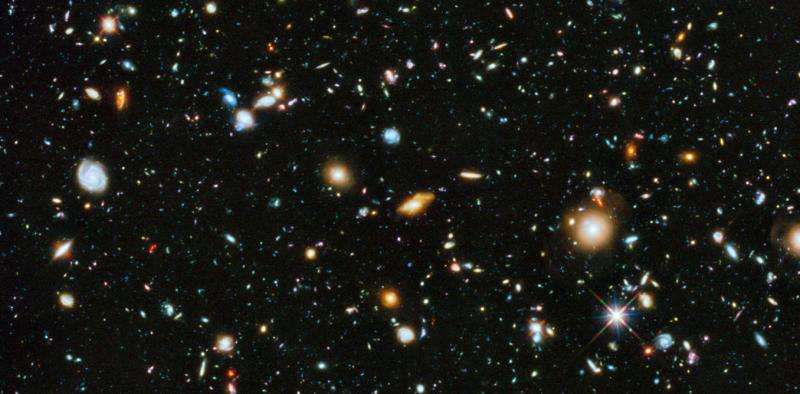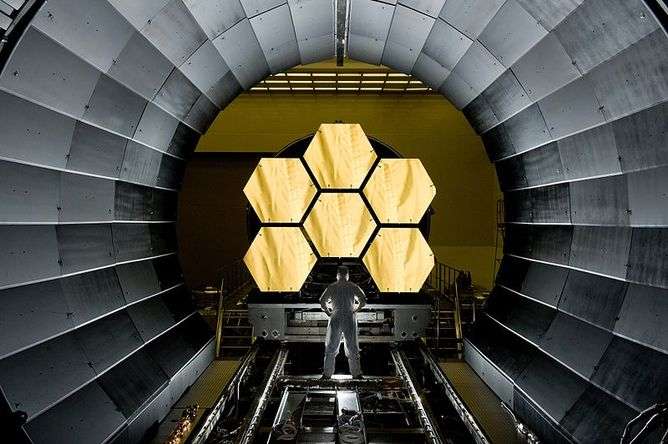Images of galaxies far away may be forever blurred – no matter how big the telescope. Credit: NASA/Hubble
Can you make out the dot at the bottom of this question mark? What if you stand a few metres away? The finest detail the average human eye can distinguish is about the size of a full stop seen at a distance of a metre. This is called "resolution". The best resolution for an optical system – like the eye – is roughly given by the ratio of the wavelength of the light you're viewing in and the size of the aperture that light is passing through.
In astronomy, resolution works just the same. This explains why we build increasingly large telescopes: not only can big telescopes collect more light and therefore see further, the bigger the aperture of the telescope, in principle the better the image.
But now a new study has suggested that the universe actually has a fundamental resolution limit, meaning no matter how big we build our telescopes we won't see the most distant galaxies as clearly as we would like.
The trouble with telescopes
The largest visible-light telescopes on Earth, such as the Very Large Telescopes and the Keck telescopes, have mirrors about ten metres in diameter, and there are now plans to build telescopes with diameters of 30m to 40m (so-called Extremely Large Telescopes). But there's a problem: if light from an object (be it a candle, streetlight or star) is perturbed on its journey from source to detection, then we will never be able to produce an image as sharp as the theoretical maximum, no matter how big we make the aperture.
The huge primary mirror of the James Webb Telescope.
We know light can play tricks on us. Ever looked at the bottom of a swimming pool and seen the tiles appear to ripple and dance? Or put a straw into a glass of water and seen it seemingly "break" between the air and the liquid? Light travelling to our telescopes from space has to pass through a turbulent atmosphere, and this causes problems for astronomers.
Like a perfect parallel set of ocean waves encountering a submerged reef, the atmosphere disturbs the waves' propagation. For electromagnetic waves – light – this has the effect of blurring images. Unless we compensate for it, it means we never reach the theoretical maximum resolution for a telescope. Putting telescopes in space, above the atmosphere, is one solution, but is costly. "Adaptive optics" is another, but is technically challenging.
Quantum foam
The new study, presented at the International Astronomical Union General Assembly this year, makes a prediction about the nature of space using the strange world of quantum physics. It argues that the nature of space-time on the quantum level might give rise to a kind of "fundamental resolution limit" of the cosmos, meaning there might be a cause to be concerned about how clearly future telescopes will be able to see the most distant galaxies.
The idea is as follows. According to quantum mechanics, on the smallest of scales, known as the Planck scale, some 10-35 m (yes, that's a decimal point with 34 zeros after it before you get to the one), space is described as "foamy". On those small scales, quantum physics predicts that the universe is seething with so-called "virtual particles" which pop into existence and then quickly annihilate each other – something seen constantly in particle physics experiments. However, for the briefest of moments those particles have energy and therefore – according to the famous equation E=mc2 – mass.
Any mass, no matter how small, is predicted to warp space-time. This is Einstein's description of gravity. The most dramatic example of this phenomenon in nature is in the gravitational lensing of distant galaxies by massive clusters. Photons – particles of light – travelling through such foaming space-time would be affected by such fluctuations in a similar manner to light passing through our thick and turbulent atmosphere.
Of course, the effect is tiny – almost negligible. But a photon emitted from a distant galaxy making the journey across the universe has to travel a long way. On this journey, the countless "phase perturbations" caused by the foamy nature of space-time might add up. Now, the prediction is that this effect is smaller than even the finest images we can currently make with the best telescopes. But – if the theory is correct – then this cosmic blurring might be apparent in images of distant galaxies made by next-generation telescopes. These include the Hubble's successor the James Webb Space Telescope, due for launch in 2018.
However, there is so far no accepted theory uniting Einstein's view of gravity with quantum mechanics – that is one of the key goals of modern physics – so we should take this prediction with a pinch of salt. Even if it is correct, its effects will only really be frustrating to the group of astrophysicists studying the detailed structure of the most distant galaxies.
What's fascinating is the implication that no matter how big we make our telescopes here on Earth or in space, there is a fundamental natural resolution limit to the universe beyond which we cannot probe, born out from quantum processes, but manifested on cosmological scales. Like a cosmic conspiracy, some of nature's secrets may be forever concealed.
Source: The Conversation
This story is published courtesy of The Conversation (under Creative Commons-Attribution/No derivatives).
![]()

























